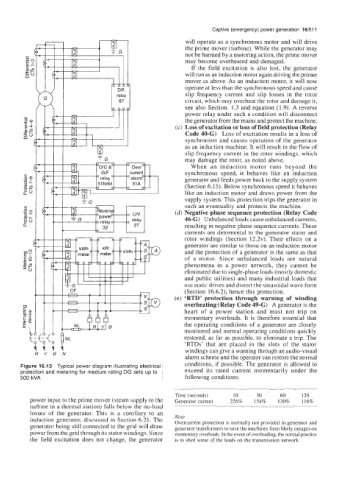Page 537 - Industrial Power Engineering and Applications Handbook
P. 537
Captive (emergency) power generation 16/51 1
will operate as a synchronous motor and will drive
the prime mover (turbine). While the generator may
not be harmed by a motoring action, the prime mover
may become overheated and damaged.
If the field excitation is also lost, the generator
will run as an induction motor again driving the primer
mover as above. As an induction motor, it will now
operate at less than the synchronous speed and cause
slip frequency current and slip losses in the rotor
circuit, which may overheat the rotor and damage it,
see also Section. 1.3 and equation (1.9). A reverse
power relay under such a condition will disconnect
the generator from the mains and protect the machine.
(c) Loss of excitation or loss of field protection (Relay
Code 40-G) Loss of excitation results in a loss of
synchronism and causes operation of the generator
as an induction machine. It will result in the flow of
slip frequency current in the rotor windings, which
may damage the rotor, as noted above.
When an induction motor runs beyond the
synchronous speed, it behaves like an induction
generator and feeds power back to the supply system
(Section 6.15). Below synchronous speed it behaves
like an induction motor and draws power from the
supply system. This protection trips the generator in
such an eventuality and protects the machine.
(d) Negative phase sequence protection (Relay Code
46-G) Unbalanced loads cause unbalanced currents,
resulting in negative phase sequence currents. These
currents are detrimental to the generator stator and
rotor windings (Section 12.2~). Their effects on a
generator are similar to those on an induction motor
and the protection of a generator is the same as that
of a motor. Since unbalanced loads are natural
phenomena in a power network, they cannot be
eliminated due to single-phase loads (mostly domestic
and public utilities) and many industrial loads that
use static drives and distort the sinusoidal wave form
(Section 16.6.2), hence this protection.
(e) ‘RTD’ protection through warning of winding
overheating (Relay Code 49-G) A generator is the
heart of a power station and must not trip on
momentary overloads. It is therefore essential that
the operating conditions of a generator are closely
monitored and normal operating conditions quickly
PNL
W? restored, as far as possible, to eliminate a trip. The
‘RTDs’ that are placed in the slots of the stator
R Y B N windings can give a warning through an audio-visual
alarm scheme and the operator can restore the normal
Figure 16.13 Typical power diagram illustrating electrical conditions, if possible. The generator is allowed to
protection and metering for medium rating DG sets up to exceed its rated current momentarily under the
500 kVA following conditions:
Time (seconds) 10 30 60 120
power input to the prime mover (steam supply to the Generator current 226% 154% 130% 116%
turbine in a thermal station) falls below the no-load
losses of the generator. This is a corollary to an
induction generator, discussed in Section 6.21. The Note
Overcurrent protection is normally not provided in generator and
generator being still connected to the grid will draw generator transformers to save the machines from likely outages on
power from the grid through its stator windings. Since momentary overloads. In the event of overloading, the normal practice
the field excitation does not change, the generator is to shed some of the loads on the transmission network.

